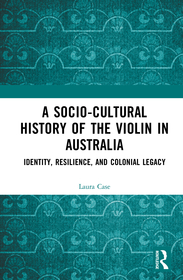
A Socio-Cultural History of the Violin in Australia
Identity, Resilience, and Colonial Legacy
-
10% KEDVEZMÉNY?
- A kedvezmény csak az 'Értesítés a kedvenc témákról' hírlevelünk címzettjeinek rendeléseire érvényes.
- Kiadói listaár GBP 145.00
-
69 273 Ft (65 975 Ft + 5% áfa)
Az ár azért becsült, mert a rendelés pillanatában nem lehet pontosan tudni, hogy a beérkezéskor milyen lesz a forint árfolyama az adott termék eredeti devizájához képest. Ha a forint romlana, kissé többet, ha javulna, kissé kevesebbet kell majd fizetnie.
- Kedvezmény(ek) 10% (cc. 6 927 Ft off)
- Kedvezményes ár 62 346 Ft (59 378 Ft + 5% áfa)
Iratkozzon fel most és részesüljön kedvezőbb árainkból!
Feliratkozom
69 273 Ft

Beszerezhetőség
Becsült beszerzési idő: A Prosperónál jelenleg nincsen raktáron, de a kiadónál igen. Beszerzés kb. 3-5 hét..
A Prosperónál jelenleg nincsen raktáron.
Why don't you give exact delivery time?
A beszerzés időigényét az eddigi tapasztalatokra alapozva adjuk meg. Azért becsült, mert a terméket külföldről hozzuk be, így a kiadó kiszolgálásának pillanatnyi gyorsaságától is függ. A megadottnál gyorsabb és lassabb szállítás is elképzelhető, de mindent megteszünk, hogy Ön a lehető leghamarabb jusson hozzá a termékhez.
A termék adatai:
- Kiadás sorszáma 1
- Kiadó Routledge
- Megjelenés dátuma 2025. augusztus 29.
- ISBN 9781041014003
- Kötéstípus Keménykötés
- Terjedelem432 oldal
- Méret 234x156 mm
- Súly 960 g
- Nyelv angol
- Illusztrációk 22 Illustrations, black & white; 15 Halftones, black & white; 7 Line drawings, black & white 691
Kategóriák
Rövid leírás:
This book presents a social history of the violin in Australia from 1788 to 1914, exploring its pivotal role in colonial society and influence on local music-making and culture. It provides scholars with new insights into how musical instruments like the violin were used to navigate and express social boundaries within a colonial framework.
TöbbHosszú leírás:
This book presents a social history of the violin in Australia from 1788 to 1914, exploring its pivotal role in colonial society and influence on local music-making and culture. It provides scholars with new insights into how musical instruments like the violin were used to navigate and express social boundaries within a colonial framework.
Initially introduced by British settlers, the violin emerged as a powerful cultural symbol across social classes, genders, and ethnic backgrounds. Through a historical lens, this narrative examines the violin’s integration into Australian society, reflecting the complexities of identity, colonial values, and Indigenous resilience. Featuring an in-depth analysis of diverse historical sources, such as newspapers, letters, and musical programmes, readers are offered a comprehensive view of Australia’s musical past. Each chapter highlights notable violinists, illustrating how the violin either reinforced or challenged existing social hierarchies. This exploration extends into broader themes of colonisation, empire, and cultural survival. By uncovering an overlooked facet of Australia’s cultural landscape, this study significantly contributes to the fields of music history, colonial studies, and Australian history.
Aimed at an academic audience, this book will appeal to those interested in colonial history, Australian music, and cultural studies. Through its detailed analysis, it offers an essential resource for understanding the ways that music served as a medium for both cultural continuity and transformation in Australia’s complex colonial context.
In this book, Laura Case provides a clever and compelling history of the violin in Australia from colonisation to 1915. She draws on an impressive range of sources and methods to tell this history and her personal connection to it. This book is not merely about the violin; it interrogates issues of gender, race and place in the instrument’s musical and cultural legacy. This book is a significant contribution to Australian as well as global history.
Professor Paul Watt, Elder Conservatorium of Music, The University of Adelaide
This important book opens up an area in the social history of music in Australia which has barely been touched before. Laura Case’s use of evidence from historical newspapers and journals gives her writing an appealing immediacy and the book’s breadth in dealing with fiddlers playing traditional and popular musics as well as middle- and upper-class violinists playing the ‘classical’ repertoire is refreshing. Stories of convict, female and Indigenous violinists come vividly to life, creating a rich and complex picture of music making in colonial Australia. I am confident that this book will become the standard text on the history of the violin in Australia, and an essential reference for the rapidly developing field of the history of indigenous music making in Australia since colonisation.
Dr. Alan Maddox, Senior Lecturer in Musicology at The University of Sydney
This important new book offers the first cultural and social history of the violin as a musical object in Australia, and one that has carried strong social meanings and values over time. Ranging from the early colonial period to the early twentieth century, Laura Case gives a lively account of the violin, the people who played it, and the social and economic forces acting upon them. She brings to life a cast of historical characters and draws readers’ attention to how the violin functions in cross-cultural settings and has been taken up by Aboriginal players and non-Indigenous musicians alike, has been played across class and social groups, and has carried different gendered associations over the centuries.
Associate Professor Amanda Harris, University of Sydney
Tartalomjegyzék:
INTRODUCTION: SETTING THE STAGE, 1. GENTEEL GENTRY – AMATEUR VIOLINISTS IN COLONIAL AUSTRALIA BETWEEN 1788-1850 2. TAVERN TUNES – FIDDLERS AND DANCE MASTERS IN COLONIAL AUSTRALIA BETWEEN 1788-1860 3. VIRTUOSIC VOYAGERS – PIONEERING SOLOIST VIOLINISTS IN COLONIAL AUSTRALIA BETWEEN 1822-1885 4. FROM MOZART TO MINSTREL – ENSEMBLE VIOLINISTS IN COLONIAL AUSTRALIA BETWEEN 1840-1890 5. CULTURAL CONTINUATION – INDIGENOUS ENCOUTERS WITH THE EUROPEAN VIOLIN 6. BREAKING BOUNDARIES – WOMEN AND THE VIOLIN IN COLONIAL AUSTRALIA BETWEEN 1870-1914, CONCLUSION: THE VIOLIN’S LEGACY IN AUSTRALIAN SOCIETY AND CULTURE
Több



